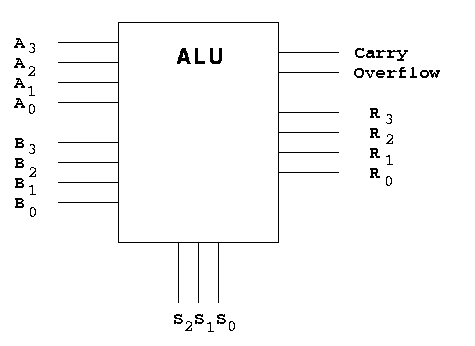Your ALU will perform eight functions on two 4-bit inputs (A and B). These inputs could represent either unsigned numbers (need carry-out), two's complement numbers (need overflow), or simply bit patterns. The ALU will generate a 4-bit output (R), a carry, and an overflow. To select which of the eight functions to implement you will need three select inputs. A block diagram is shown in Figure 1.

Figure 1: The ALU block diagram.
The functions to be implemented for the various select inputs are shown in Table 1.
| S2S1S0 | Function | Description |
| 000 | A plus B | Add A and B |
| 001 | A minus B | Subtract B from A |
| 010 | B plus 1 | Increment B |
| 011 | B minus 1 | Decrement B |
| 100 | minus A | In Two's Complement form |
| 101 | not A | bitwise Complement of A |
| 110 | A or B | Logical OR of A and B |
| 111 | A and B | Logical AND of A and B |
Table 1: ALU Functions.
Implementing the ALU using Altera is easy. For example, to implement the ADD function, you could use the following statement:
WHEN 0 =>
(carry_out, r[3..0]) = (0, a[3..0]) + (0, b[3..0]);
overflow = (a[3]&b[3]&!r[3]) OR (!a[3]&!b[3]&r[3]);
This will add two 4-bit numbers with a carry output (unsigned number interpretation). If as a result of the addition of the two four-bit numbers, A and B, a carry is generated, the fifth bit of the result (carry_out) will be set. The overflow bit is set when the sum of two positive numbers produces a negative number (two's complement number interpretation), or the sum of two negative numbers produces a positive number. The other functions are equally simple to implement. You should look in the Altera MAX+PLUS II online help to find out how to realize the other ALU functions.
Check your design by using the Altera simulator. Your ALU has eleven inputs, giving 211=2048 possible combinations. It would be tedious to check all 2048 combinations by hand. It would, however, be possible to write a computer program to determine if all the outputs were correct. For this lab, you only have to check a few examples of each function to see if the ALU is working properly.
A computer with a 64-bit floating-point unit (FPU) has 2128 possible input combinations for two input numbers. If the ALU performs eight functions, there are 2136 possible combinations to check. If a test program could check one billion combinations a second, it would take ~3 x 1024 years to check all possible input combinations. Since the universe is only about 1010 years old, this is clearly impossible. In modern computers, engineers can only test a representative selection of possible inputs. Determining which representative set to check is a high art. Occasionally, bugs can slip in, such as occurred with the recent bug(s) in the Intel 820 support chipset.
For A = 1111 and B = 0010 simulate all the ALU functions, and check your results with the expected values. Repeat your check for A = 1001 and B = 0111.
Program your Altera chip to implement your ALU. Recalling that A and B could be unsigned numbers, two's Complement numbers, or simply bit patterns do the following:
- Use the logic analyzer, with A = 1111 and B = 0010, and the 74HC4040A counter chip to cycle through all eight select choices, to test the functionality of your ALU.
- Repeat part a. with A = 1001 and B = 0111.